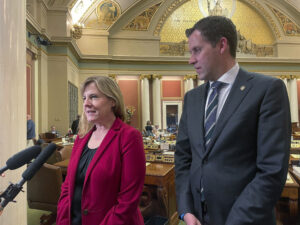Population Boom in the Freezer
Since the 1980s, more than a half-million children have been created through in vitro fertilization. There are also about a half-million leftover embryos.I hate to revisit Nadya Suleman, the woman so charmingly dubbed “octomom” by the tabloids. Especially now when she’s busy chatting with Dr. Phil, raising money on her Web site, and preparing to move with 14 children into a new $565,000 shoe, excuse me, house.
But there is a reason for all of us to be grateful to octomom. She has created a consensus where none existed. We now know exactly what should not be done with the leftover embryos languishing in fertility clinic freezers. They should not be given to Nadya.
I return to octomom because President Obama lifted the ban on federal funding for stem cell research this week. This is a debate that hinged on the moral status of the embryo. To be more precise, it hinged on the status of a spare embryo.
In case you missed Stem Cells 101, the only way to harvest these cells is to destroy the embryo. Since most people are rightly queasy about creating new embryos just to destroy them, researchers looked to the embryos languishing in clinic freezers after couples finished in vitro fertilization treatment.
This brought the argument over the value of life into morally ambiguous territory. What does it mean to favor the life of a three-day embryo over a grandparent with Parkinson’s disease?
Some absolutists, including George W. Bush, said “there is no such thing as a spare embryo.” They argued for embryo “adoption,” which never exactly took off. Most Americans, who believe that an embryo is neither a child nor a mere blob of tissue, came to agree that it was better to let embryos be used in pursuit of a cure than to remain in an icy limbo.
The intriguing thing is that while this heated debate went on, there was a virtual silence on the question of what should happen to the vast majority of frozen embryos that will never be used for either fertility or research. Indeed, the public wrangling barely included the people most involved in private decisions: the couples who created these embryos.
Since the 1980s, more than a half-million children have been created through IVF. There are also about a half-million leftover embryos. A third of the couples storing embryos have more than six, and at least one cryobank offering a prepaid five-year price of $1,188 says the embryos “can remain viable for an indefinite period of time.”
Indefinite? Until couples are post-menopausal? Or post-mortem? Are they to be passed on from one generation to the next?
The understandable problem, says Duke researcher and OB-GYN Anne Lyerly, is that doctors and patients are focused on creating embryos and producing babies. Most couples are asked to sign a consent form about their leftover embryos at the beginning of treatment. Some are never asked. And many change their minds.
Couples face the decision with hugely mixed emotions. For some, as bioethicist Alta Charo says, embryos “represent an imagined future” that is hard to relinquish. It’s easier to decide not to decide.
When Dr. Lyerly conducted a rare survey of patients, she found the desire for a range of options, from donating for research to thawing and discarding. There was, as well, a hidden longing for a ceremony, a ritual goodbye. The good news for stem cell researchers is that 60 percent said they were likely or very likely to donate, but we may not need more than a small fraction of those embryos.
If octomom is any lesson — and I hope she is — doctors will be implanting fewer embryos but may end up with more spares. If we can eventually tweak adult cells to be used, the need for stem cells will go down further. We are heading for a population explosion in the freezer.
So what will we do with the eternal embryos? The American Society of Reproductive Medicine guidelines say that clinics can thaw embryos “abandoned” by patients who cannot be located, but few do. No doctor wants to face the couple who missed the deadline.
At the very least, couples should reconsider and renew their consent form at the end of treatment and whenever they pay for storage. We should, finally, begin a real conversation about the responsibility for these “unintended consequences.”
What was it that Obama said? That we were resolving a “false choice between sound science and moral values.” Well, there are more choices — true but hard — waiting to be made. That’s half a million and counting.
Ellen Goodman’s e-mail address is ellengoodman(at)globe.com.
© 2009, Washington Post Writers Group
Your support matters…Independent journalism is under threat and overshadowed by heavily funded mainstream media.
You can help level the playing field. Become a member.
Your tax-deductible contribution keeps us digging beneath the headlines to give you thought-provoking, investigative reporting and analysis that unearths what's really happening- without compromise.
Give today to support our courageous, independent journalists.






You need to be a supporter to comment.
There are currently no responses to this article.
Be the first to respond.